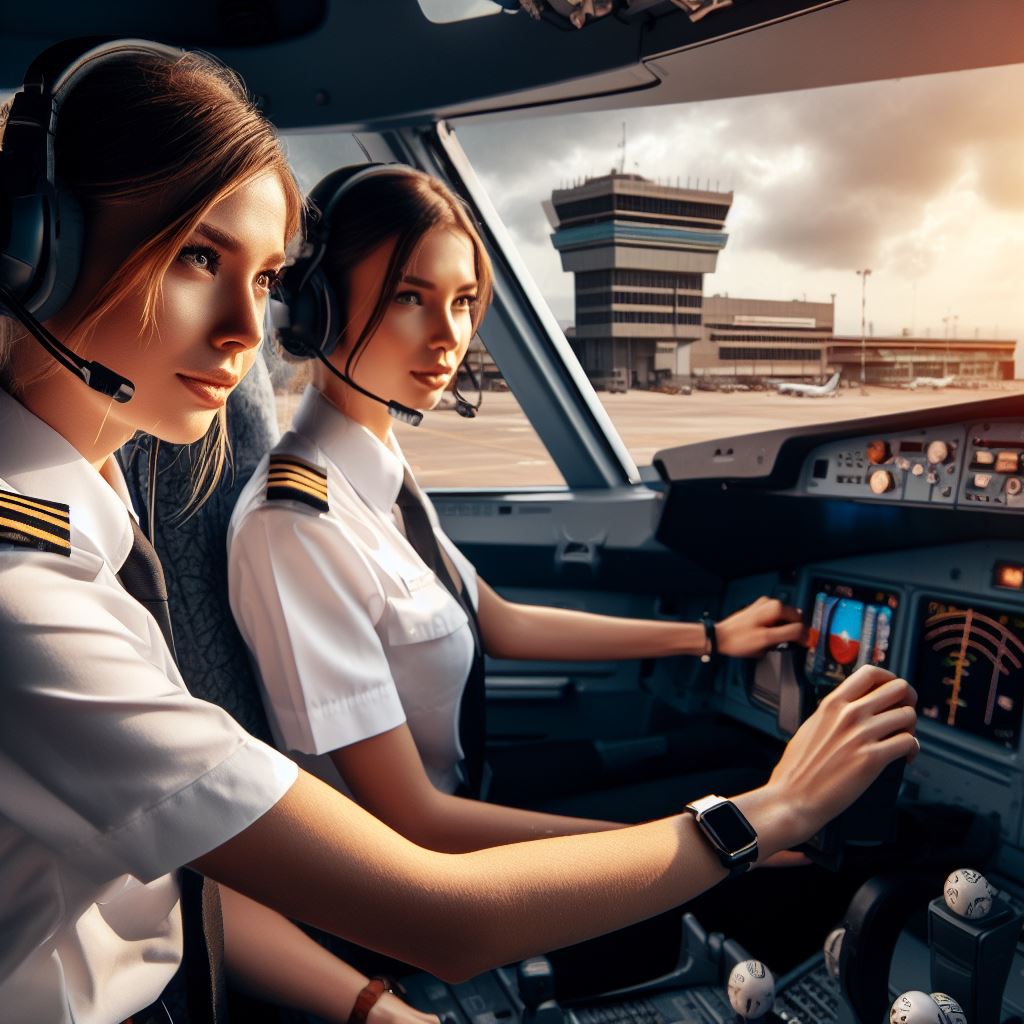Introduction
A. Definition of Pilot
A pilot, a skilled aviator, navigates aircraft, ensuring safe travel for passengers and cargo. Their role is pivotal.
B. Importance of Pilots in the Aviation Industry
Pilots are the backbone of aviation, responsible for safety and efficiency in air travel. Their expertise is irreplaceable.
C. Significance of Discussing the Demand for Pilots in the US
- Booming Aviation Industry: The US aviation sector is expanding, creating a surge in demand for qualified pilots.
- Economic Impact: Pilot shortages can impact the economy, affecting air travel, freight, and related industries.
- Career Opportunities: Understanding trends in pilot demand provides insight for those considering or already in the aviation profession.
Overview of the Aviation Industry in the US
A. Growth and development of the industry
- The aviation industry in the US has experienced significant growth and development over the years.
- Advancements in technology have played a crucial role in shaping the industry’s progress.
- Improved aircraft designs, navigation systems, and communication tools have made air travel safer and more efficient.
- This growth is reflected in the increasing number of airports, airlines, and aircraft manufacturers.
- Furthermore, the demand for air travel has also spurred the expansion and modernization of existing airports.
- The industry has witnessed a substantial increase in passenger traffic, both domestically and internationally.
- Overall, the growth and development of the aviation industry have contributed to the country’s economic prosperity.
B. Contribution to the national economy
- The aviation industry is a vital contributor to the US economy.
- It generates significant job opportunities, contributing to employment growth across various sectors.
- Airlines, airports, aircraft manufacturers, and related services together support millions of jobs.
- The industry’s economic impact extends beyond direct employment, as it also drives tourism and stimulates related industries.
- Airports act as economic hubs, attracting businesses and creating a favorable environment for trade and investment.
- The aviation industry also plays a crucial role in transporting goods and facilitating global trade.
C. Factors influencing the demand for pilots
- The demand for pilots in the US is influenced by various factors.
- The growth of the aviation industry directly impacts pilot demand, as more aircraft require qualified pilots.
- Airlines expanding their fleets and opening new routes create employment opportunities for pilots.
- The retirement of experienced pilots has also contributed to the increasing demand for new pilots.
- Furthermore, advancements in technology and aircraft automation have altered the role of pilots.
- The industry now demands pilots with modern skill sets and adaptability to new technologies.
- The demand for pilots is also affected by governmental regulations and safety requirements.
- Changes in these regulations can have an impact on pilot training standards and employment opportunities.
In essence, the aviation industry in the US has undergone significant growth and development, contributing to the country’s economy.
Factors such as advancements in technology, increasing passenger traffic, and economic benefits have propelled this growth.
The demand for pilots has risen alongside the industry’s expansion, driven by fleet expansion, retirement of experienced pilots, and changing technology requirements.
Understanding these factors is crucial for individuals considering a career in aviation and for policymakers involved in shaping the industry’s future.
Read: Top Paying Trucking Companies in the United States
Current Trends in the Demand for Pilots
Air travel has seen a significant increase in recent years, leading to a greater demand for pilots in the United States.
This demand is driven by various current trends that shape the industry and influence pilot employment.
A. Increase in air travel
One major trend contributing to the demand for pilots is the overall increase in air travel.
Domestic and international flights are on the rise, with more people choosing to travel by air.
This growth in air travel is accompanied by the expansion of airlines and routes, necessitating a larger number of pilots to accommodate the increasing number of flights.
B. Retirement of experienced pilots
Another important factor affecting the demand for pilots is the retirement of experienced pilots.
The pilot workforce is aging, and many experienced pilots are reaching the mandatory retirement age.
As these pilots retire, there is a need for replacements to fill their positions.
This creates opportunities for aspiring pilots and contributes to the overall demand for qualified individuals in the profession.
C. Technological advancements
Technological advancements in the aviation industry also play a significant role in shaping the demand for pilots.
The introduction of new aircraft and systems requires pilots to possess specific skills and training to operate these advanced technologies.
As a result, there is a growing need for pilots who are proficient in the use of new systems and able to adapt to rapidly evolving aviation technology.
These technological advancements not only impact pilot requirements but also influence pilot training.
Transform Your Career Today
Unlock a personalized career strategy that drives real results. Get tailored advice and a roadmap designed just for you.
Start NowPilots now need to undergo additional training to familiarize themselves with the new aircraft and systems.
This transition to more advanced technology requires a skilled workforce, as pilots must be well-trained and equipped to handle the complexities and demands of modern aviation.
In fact, the demand for pilots in the United States is influenced by several current trends.
The increase in air travel, retirement of experienced pilots, and technological advancements all contribute to the need for a larger pilot workforce.
As the industry continues to evolve, it is crucial for aspiring pilots to stay updated on these trends and acquire the necessary skills and qualifications to meet the demand in the ever-changing aviation industry.
Read: Why Trucking Remains Vital to the US Economy

Pilot Shortage and Its Consequences
A. Statistics and projections
The demand for pilots in the US has reached a critical point, with a shortage that is expected to have far-reaching consequences.
Surveys and studies on pilot shortage have indicated that the problem is growing, and projections suggest that there will be a significant shortfall in the coming years.
B. Effects on the aviation industry
The effects of the pilot shortage on the aviation industry cannot be ignored.
Existing pilots will face an increased workload as airlines struggle to fill the vacant positions.
This increased workload could potentially lead to a decline in safety standards, as pilots may be overstretched and fatigued.
Passengers may also experience the impact of the shortage through higher air travel costs and reduced availability of flights.
C. Measures taken to address the shortage
To address the pilot shortage, airlines and flight schools have taken various measures.
Airlines have implemented initiatives to attract and retain pilots, such as improved compensation packages and work-life balance programs.
Flight schools have also stepped up efforts to recruit and train aspiring pilots, offering scholarships and financial assistance.
In addition to industry efforts, the government has introduced programs and incentives to address the shortage.
These include grants for pilot training programs and tax incentives for airlines that invest in pilot recruitment and retention.
The goal is to encourage more individuals to pursue careers as pilots and meet the growing demand.
Despite these measures, the pilot shortage remains a pressing issue.
The industry needs to continue finding innovative solutions to attract and retain pilots.
Transform Your Career Today
Unlock a personalized career strategy that drives real results. Get tailored advice and a roadmap designed just for you.
Start NowEfforts should focus not only on recruitment but also on creating a supportive and rewarding work environment for pilots.
This can include initiatives to improve work-life balance, enhance career progression opportunities, and invest in continuous training and development.
In general, the pilot shortage in the US poses significant challenges for the aviation industry.
The increased workload for existing pilots, potential decline in safety standards, and impact on air travel costs and availability are all consequences that need to be addressed.
Through industry initiatives and government programs, steps are being taken to alleviate the shortage and encourage more individuals to pursue careers as pilots.
However, ongoing efforts are required to ensure a sustainable supply of pilots and maintain the highest standards of safety and efficiency in air travel.
Read: Stories from the Road: Interviews with Veteran Truckers
Opportunities and Challenges for Aspiring Pilots
A. Availability of Pilot Training Programs
1. Types of Flight Schools and Training Options
Aspiring pilots have the option to choose from a variety of flight schools and training programs.
These include university-based aviation programs, independent flight schools, and pilot academies.
Each type of school offers different training approaches and may cater to specific aviation sectors, such as commercial aviation or general aviation.
2. Financial Considerations and Support
One of the major challenges for aspiring pilots is the cost associated with pilot training.
Flight training programs can be expensive, especially those offered by universities or academies.
However, there are scholarship opportunities and financial aid packages available for students pursuing aviation careers.
Some aviation organizations and airlines also offer sponsorship programs and loan options to support aspiring pilots in their training journey.
B. Career Prospects and Job Security
1. Job Outlook for Pilots
The demand for pilots is expected to continue growing, especially as air transportation expands globally.
An increase in passenger and cargo traffic, along with retirements of current pilots, creates job openings for aspiring professionals.
However, it is essential for aspiring pilots to stay updated with industry trends and adapt to technological advancements, as these factors can influence job prospects.
2. Potential Areas of Employment
Pilots have a wide range of career options available to them. The most common path is joining a commercial airline as a pilot.
However, other employment opportunities include cargo and charter airlines, regional carriers, private aviation sectors, government agencies, and military aviation.
The choice of sector depends on personal preference, career goals, and individual qualifications.
Transform Your Career Today
Unlock a personalized career strategy that drives real results. Get tailored advice and a roadmap designed just for you.
Start NowC. Skills and Qualifications Required
1. Educational and Licensing Requirements
Aspiring pilots are required to meet certain educational and licensing requirements.
These typically include obtaining a private pilot license (PPL), instrument rating, commercial pilot license (CPL), and multi-engine rating.
The requirements may also involve a specific number of flight hours, written exams, and practical flight tests.
Additionally, some aviation sectors may require additional certifications and ratings.
2. Importance of Experience and Soft Skills
In addition to the formal qualifications, experience is highly valued in the aviation industry.
Building flight hours as a pilot-in-command and gaining practical experience in different weather conditions and aircraft types enhances an aspiring pilot’s chances of securing employment.
Moreover, soft skills such as effective communication, problem-solving abilities, and teamwork are crucial for successful pilots, as they often work in high-pressure environments and need to interact with diverse stakeholders.
Essentially, aspiring pilots have various opportunities and challenges to consider when pursuing a career in aviation.
The availability of pilot training programs, including different types of flight schools and financial considerations, plays a significant role in their journey.
Additionally, understanding the job outlook and potential areas of employment, along with the required skills and qualifications, are crucial for aspiring pilots to successfully navigate their path in this exciting and rewarding profession.
Read: The Environmental Impact of Trucking in the US
Conclusion
A. Recap of the demand for pilots in the US
The demand for pilots in the US is growing rapidly due to various factors such as the expansion of airlines, retirement of experienced pilots, and increased air travel.
This demand is expected to continue in the coming years.
B. Summary of current trends and their impact
One of the current trends in the industry is the implementation of advanced technology in aircraft, which requires pilots to have new skills and knowledge.
Additionally, the COVID-19 pandemic has greatly impacted the aviation industry, resulting in layoffs and reduced demand for pilots.
C. Importance of understanding the opportunities and challenges in the industry
It is crucial for aspiring pilots and aviation professionals to be aware of the current trends and their impact on the demand for pilots.
Understanding these opportunities and challenges can help individuals make informed decisions about their careers and adapt to the changing dynamics of the industry.




